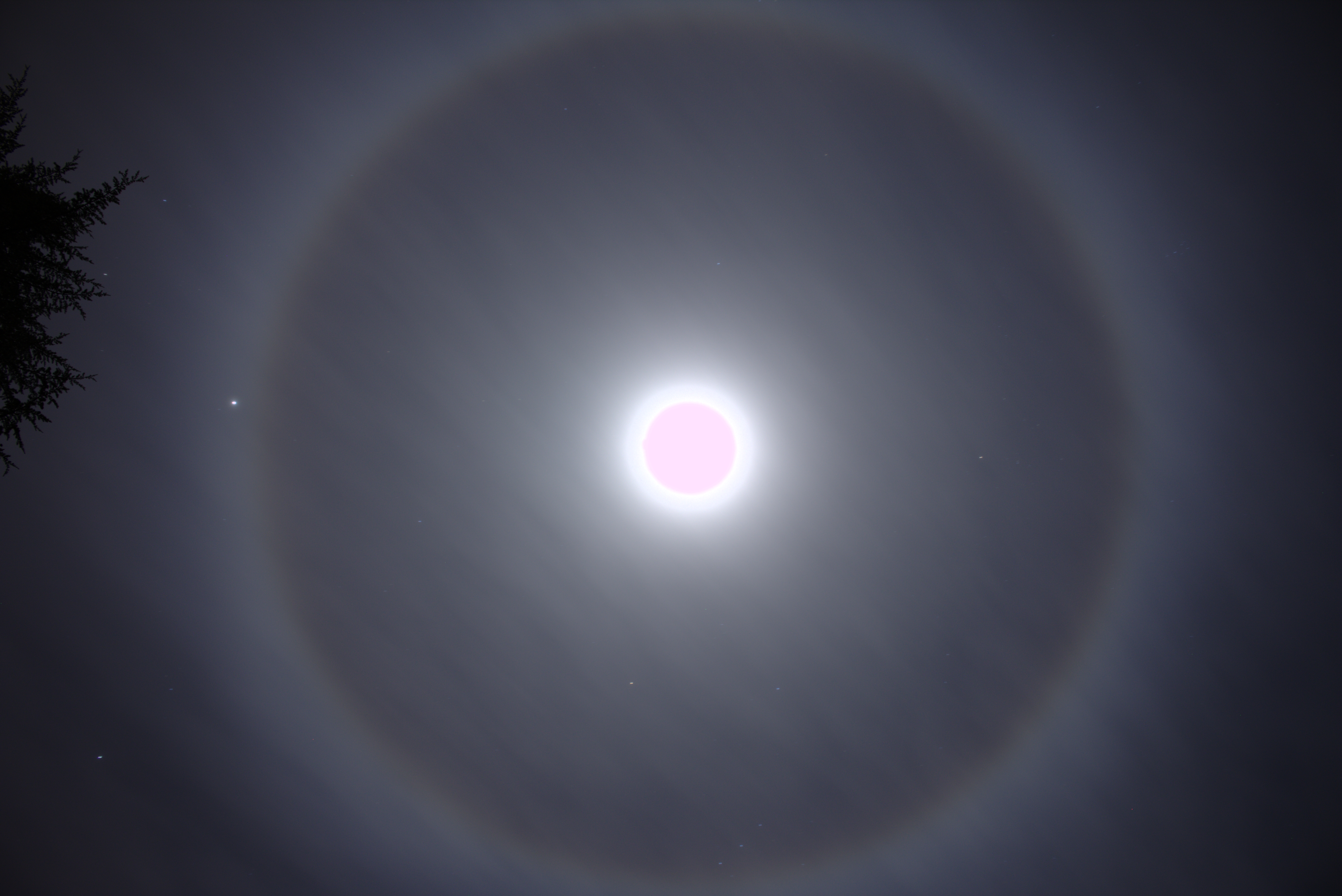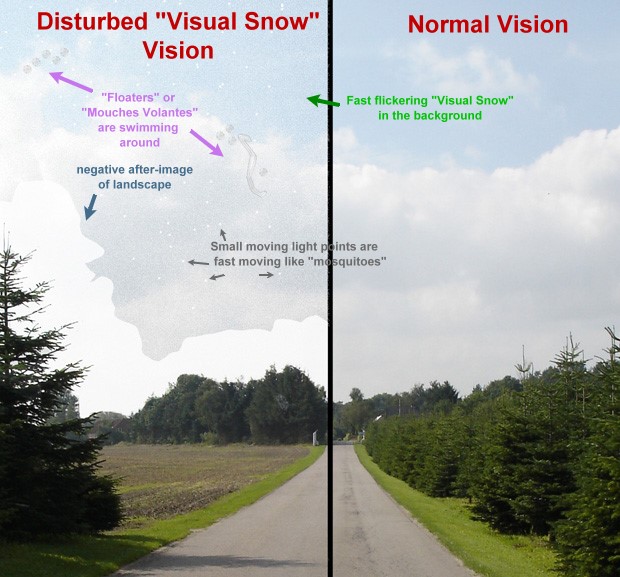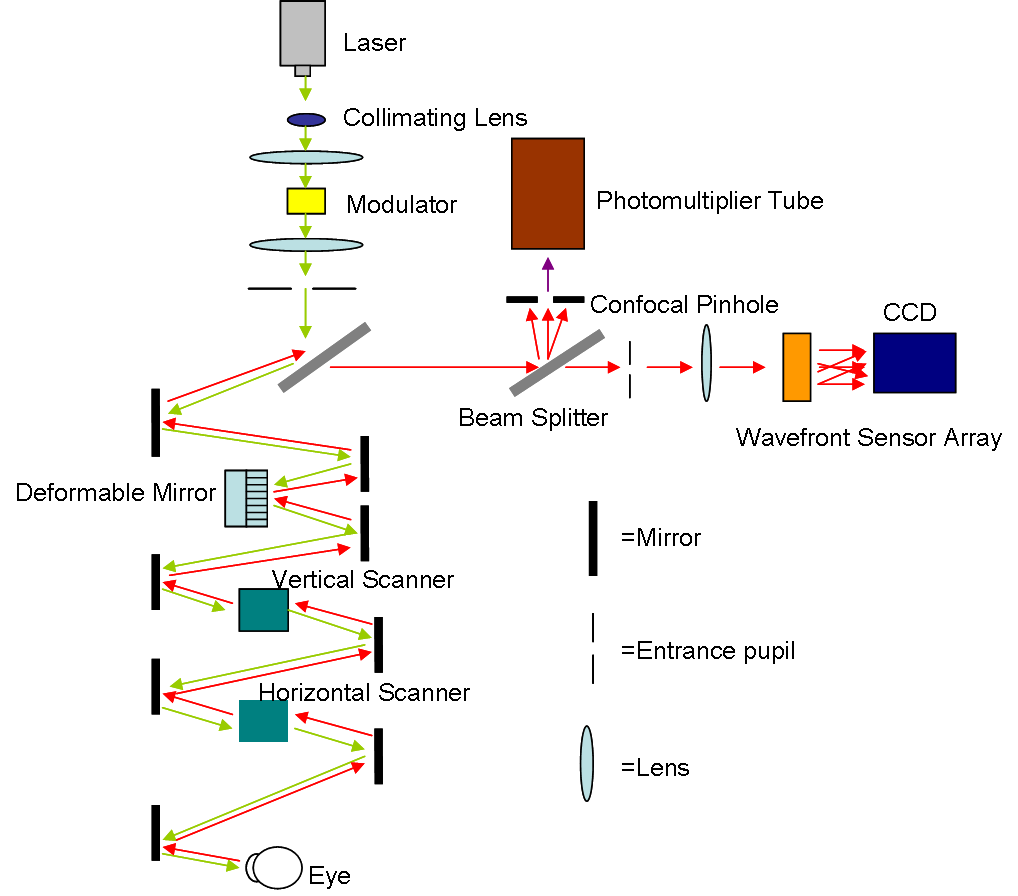|
Blue Field Entoptic Phenomenon
The blue field entoptic phenomenon is an entoptic phenomenon characterized by the appearance of tiny bright dots (nicknamed blue-sky sprites) moving quickly along squiggly lines in the visual field, especially when looking into bright blue light such as the sky. The dots are short-lived, visible for a second or less, and traveling short distances along seemingly random, curvy paths. Some of them follow the same path as predecessors. The dots may be elongated along the path like tiny worms. The speed of the dots varies in sync with the pulse; they briefly accelerate at each heartbeat. The dots appear in the central field of view, within 15 degrees from the fixation point. The left and right eye see different dots; someone looking with both eyes sees a mixture. Most people are able to see this phenomenon in the sky, although it is rather weak, and many people do not notice it until asked to pay attention. The dots are highly conspicuous against a monochromatic blue background (~43 ... [...More Info...] [...Related Items...] OR: [Wikipedia] [Google] [Baidu] |
Entoptic Phenomenon
Entoptic phenomena () are visual effects whose source is within the human eye itself. (Occasionally, these are called entopic phenomena, which is probably a typographical mistake.) In Helmholtz's words: "Under suitable conditions light falling on the eye may render visible certain objects within the eye itself. These perceptions are called ''entoptical''." Overview Entoptic images have a physical basis in the image cast upon the retina. Hence, they are different from optical illusions, which are caused by the visual system and characterized by a visual percept that (loosely said) appears to differ from reality. Because entoptic images are caused by phenomena within the observer's own eye, they share one feature with optical illusions and hallucinations: the observer cannot share a direct and specific view of the phenomenon with others. Helmholtz commented on entoptic phenomena which could be seen easily by some observers, but could not be seen at all by others. This variance is ... [...More Info...] [...Related Items...] OR: [Wikipedia] [Google] [Baidu] |
1 E-7 M
The following are examples of orders of magnitude for different lengths. __TOC__ Overview Detailed list To help compare different orders of magnitude, the following list describes various lengths between 1.6 \times 10^ metres and 10^metres. Subatomic scale Atomic to cellular scale Cellular to human scale Human to astronomical scale Astronomical scale Less than 1 zeptometre The ' ( SI symbol: ') is a unit of length in the metric system equal to . To help compare different orders of magnitude, this section lists lengths shorter than 10−21 m (1 zm). *1.6 × 10−5 quectometres (1.6 × 10−35 metres) – the Planck length (Measures of distance shorter than this do not make physical sense, according to current theories of physics.) *1 qm – 1 quectometre, the smallest named subdivision of the metre in the SI base unit of length, one nonillionth of a metre *1 rm – 1 rontometre, a subdivision of the metre in the SI base unit of length, one octilliont ... [...More Info...] [...Related Items...] OR: [Wikipedia] [Google] [Baidu] |
Optical Phenomena
Optical phenomena are any observable events that result from the interaction of light and matter. All optics, optical phenomena coincide with Quantum mechanics, quantum phenomena. Common optical phenomena are often due to the interaction of light from the sun or moon with the atmosphere, clouds, water, dust, and other particulates. One common example is the rainbow, when light from the sun is reflected and refracted by water droplets. Some phenomena, such as the green ray, are so rare they are sometimes thought to be mythical. Others, such as Fata Morgana (mirage), Fata Morganas, are commonplace in favored locations. Other phenomena are simply interesting aspects of optics, or optical effects. For instance, the colors generated by a dispersive prism, prism are often shown in classrooms. List Optical phenomena include those arising from the optical properties of the atmosphere; the rest of nature (other phenomena); of physical body, objects, whether natural or human-made (optic ... [...More Info...] [...Related Items...] OR: [Wikipedia] [Google] [Baidu] |
Floater
Floaters or eye floaters are sometimes visible deposits (e.g., the shadows of tiny structures of protein or other cell debris projected onto the retina) within the eye's vitreous humour ("the vitreous"), which is normally transparent, or between the vitreous and retina.Cline D; Hofstetter HW; Griffin JR. ''Dictionary of Visual Science''. 4th ed. Butterworth-Heinemann, Boston 1997. They can become particularly noticeable when looking at a blank surface or an open monochromatic space, such as blue sky. Each floater can be measured by its size, shape, consistency, refractive index, and motility. They are also called ''muscae volitantes'' (Latin for 'flying flies'), or ''mouches volantes'' (from the same phrase in French). The vitreous usually starts out transparent, but imperfections may gradually develop as one ages. The common type of floater, present in most people's eyes, is due to these degenerative changes of the vitreous. The perception of floaters, which may be annoying ... [...More Info...] [...Related Items...] OR: [Wikipedia] [Google] [Baidu] |
Entoptic Phenomenon
Entoptic phenomena () are visual effects whose source is within the human eye itself. (Occasionally, these are called entopic phenomena, which is probably a typographical mistake.) In Helmholtz's words: "Under suitable conditions light falling on the eye may render visible certain objects within the eye itself. These perceptions are called ''entoptical''." Overview Entoptic images have a physical basis in the image cast upon the retina. Hence, they are different from optical illusions, which are caused by the visual system and characterized by a visual percept that (loosely said) appears to differ from reality. Because entoptic images are caused by phenomena within the observer's own eye, they share one feature with optical illusions and hallucinations: the observer cannot share a direct and specific view of the phenomenon with others. Helmholtz commented on entoptic phenomena which could be seen easily by some observers, but could not be seen at all by others. This variance is ... [...More Info...] [...Related Items...] OR: [Wikipedia] [Google] [Baidu] |
Visual Snow
Visual snow syndrome (VSS) is an uncommon neurological condition in which the primary symptom is that affected individuals see persistent flickering white, black, transparent, or coloured dots across the whole visual field. Other common symptoms are palinopsia, enhanced entoptic phenomena, photophobia, and headaches. The condition is typically always present and has no known cure, as viable treatments are still under research. Migraine and tinnitus are common comorbidities and are both associated with a more severe presentation of the syndrome. The cause of the syndrome is unclear. The underlying mechanism is believed to involve excessive excitability of neurons in the right lingual gyrus and left anterior lobe of cerebellum. Another hypothesis proposes that visual snow syndrome could be a type of thalamocortical dysrhythmia and may involve the thalamic reticular nucleus (TRN). A failure of inhibitory action from the TRN to the thalamus may be the underlying cause for inabilit ... [...More Info...] [...Related Items...] OR: [Wikipedia] [Google] [Baidu] |
Vitreous Humor
The vitreous body (''vitreous'' meaning "glass-like"; , ) is the clear gel that fills the space between the lens and the retina of the eyeball (the vitreous chamber) in humans and other vertebrates. It is often referred to as the vitreous humor (also spelled humour, from Latin meaning liquid) or simply "the vitreous". Vitreous fluid or "liquid vitreous" is the liquid component of the vitreous gel, found after a vitreous detachment. It is not to be confused with the aqueous humor, the other fluid in the eye that is found between the cornea and lens. Structure The vitreous humor is a transparent, colorless, gelatinous mass that fills the space in the eye between the lens and the retina. It is surrounded by a layer of collagen called the vitreous membrane (or hyaloid membrane or vitreous cortex) separating it from the rest of the eye. It makes up four-fifths of the volume of the eyeball. The vitreous humour is fluid-like near the centre, and gel-like near the edges. The vitreous hu ... [...More Info...] [...Related Items...] OR: [Wikipedia] [Google] [Baidu] |
Floater
Floaters or eye floaters are sometimes visible deposits (e.g., the shadows of tiny structures of protein or other cell debris projected onto the retina) within the eye's vitreous humour ("the vitreous"), which is normally transparent, or between the vitreous and retina.Cline D; Hofstetter HW; Griffin JR. ''Dictionary of Visual Science''. 4th ed. Butterworth-Heinemann, Boston 1997. They can become particularly noticeable when looking at a blank surface or an open monochromatic space, such as blue sky. Each floater can be measured by its size, shape, consistency, refractive index, and motility. They are also called ''muscae volitantes'' (Latin for 'flying flies'), or ''mouches volantes'' (from the same phrase in French). The vitreous usually starts out transparent, but imperfections may gradually develop as one ages. The common type of floater, present in most people's eyes, is due to these degenerative changes of the vitreous. The perception of floaters, which may be annoying ... [...More Info...] [...Related Items...] OR: [Wikipedia] [Google] [Baidu] |
Fovea Centralis
The fovea centralis is a small, central pit composed of closely packed cones in the eye. It is located in the center of the macula lutea of the retina. The fovea is responsible for sharp central vision (also called foveal vision), which is necessary in humans for activities for which visual detail is of primary importance, such as reading and driving. The fovea is surrounded by the ''parafovea'' belt and the ''perifovea'' outer region. The parafovea is the intermediate belt, where the ganglion cell layer is composed of more than five layers of cells, as well as the highest density of cones; the perifovea is the outermost region where the ganglion cell layer contains two to four layers of cells, and is where visual acuity is below the optimum. The perifovea contains an even more diminished density of cones, having 12 per 100 micrometres versus 50 per 100 micrometres in the most central fovea. That, in turn, is surrounded by a larger peripheral area, which delivers highly compres ... [...More Info...] [...Related Items...] OR: [Wikipedia] [Google] [Baidu] |
Scanning Laser Ophthalmoscopy
Scanning laser ophthalmoscopy (SLO) is a method of examination of the eye. It uses the technique of confocal laser scanning microscopy for diagnostic imaging of the retina or cornea of the human eye. As a method used to image the retina with a high degree of spatial sensitivity, it is helpful in the diagnosis of glaucoma, macular degeneration, and other retinal disorders. It has further been combined with adaptive optics technology to provide sharper images of the retina."Roorda Lab" — (last accessed: 9 December 2006) Published on October 25, 2006—(last accessed: 9 December 2006) Scanning laser ophthalmoscopy SLO utilizes horizontal and vertical scanning mirrors to scan a specific region of ...[...More Info...] [...Related Items...] OR: [Wikipedia] [Google] [Baidu] |
Adaptive Optics
Adaptive optics (AO) is a technology used to improve the performance of optical systems by reducing the effect of incoming wavefront distortions by deforming a mirror in order to compensate for the distortion. It is used in astronomical telescopes and laser communication systems to remove the effects of atmospheric distortion, in microscopy, optical fabrication and in retinal imaging systems to reduce optical aberrations. Adaptive optics works by measuring the distortions in a wavefront and compensating for them with a device that corrects those errors such as a deformable mirror or a liquid crystal array. Adaptive optics should not be confused with active optics, which works on a longer timescale to correct the primary mirror geometry. Other methods can achieve resolving power exceeding the limit imposed by atmospheric distortion, such as speckle imaging, aperture synthesis, and lucky imaging, or by moving outside the atmosphere with space telescopes, such as the Hubble Sp ... [...More Info...] [...Related Items...] OR: [Wikipedia] [Google] [Baidu] |
Photoreceptor Cells
A photoreceptor cell is a specialized type of neuroepithelial cell found in the retina that is capable of visual phototransduction. The great biological importance of photoreceptors is that they convert light (visible electromagnetic radiation) into signals that can stimulate biological processes. To be more specific, photoreceptor proteins in the cell absorb photons, triggering a change in the cell's membrane potential. There are currently three known types of photoreceptor cells in mammalian eyes: rods, cones, and intrinsically photosensitive retinal ganglion cells. The two classic photoreceptor cells are rods and cones, each contributing information used by the visual system to form an image of the environment, sight. Rods primarily mediate scotopic vision (dim conditions) whereas cones primarily mediate to photopic vision (bright conditions), but the processes in each that supports phototransduction is similar. A third class of mammalian photoreceptor cell was discovered ... [...More Info...] [...Related Items...] OR: [Wikipedia] [Google] [Baidu] |






